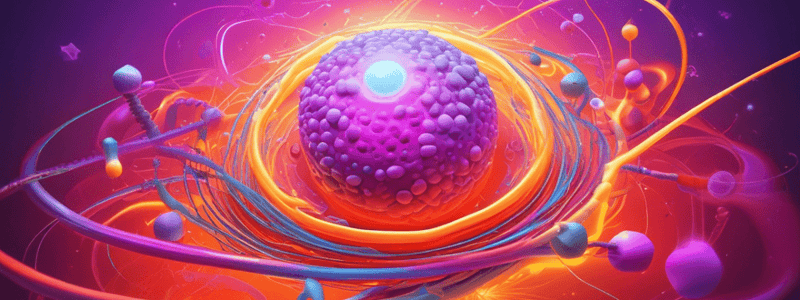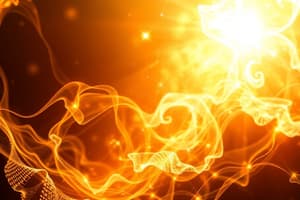Podcast
Questions and Answers
What is the primary role of ATP in cellular metabolism?
What is the primary role of ATP in cellular metabolism?
- To provide energy for unfavorable biochemical reactions (correct)
- To facilitate the transfer of phosphate groups
- To store energy from exergonic reactions
- To act as a reducing agent in redox reactions
Which of the following statements about the free energy change ($\Delta G$) of a reaction is correct?
Which of the following statements about the free energy change ($\Delta G$) of a reaction is correct?
- $\Delta G$ is constant for a given reaction, regardless of conditions
- $\Delta G$ is additive for coupled reactions (correct)
- $\Delta G$ is always negative for spontaneous reactions
- $\Delta G$ is independent of substrate and product concentrations
What is the primary function of activated intermediates like ATP in metabolism?
What is the primary function of activated intermediates like ATP in metabolism?
- To store energy from exergonic reactions
- To facilitate the transfer of specific groups between molecules (correct)
- To act as reducing agents in redox reactions
- To increase the entropy of the system
What is the principle behind thermogenesis in living organisms?
What is the principle behind thermogenesis in living organisms?
In a redox reaction, what determines the direction of electron flow?
In a redox reaction, what determines the direction of electron flow?
What is the primary role of coenzyme A (CoA) in metabolism?
What is the primary role of coenzyme A (CoA) in metabolism?
What happens to the value of ΔG° when the equilibrium constant (K_eq) is greater than 1?
What happens to the value of ΔG° when the equilibrium constant (K_eq) is greater than 1?
Which of the following statements about ΔG and K_eq is true?
Which of the following statements about ΔG and K_eq is true?
When a stress is applied to a system at equilibrium, how does the equilibrium shift?
When a stress is applied to a system at equilibrium, how does the equilibrium shift?
What is the effect of continuously supplying or removing a reactant or product on a metabolic reaction?
What is the effect of continuously supplying or removing a reactant or product on a metabolic reaction?
How does an increase in temperature affect an endothermic reaction at equilibrium?
How does an increase in temperature affect an endothermic reaction at equilibrium?
What is the role of ATP in cellular energy transformations?
What is the role of ATP in cellular energy transformations?
What is the definition of bioenergetics according to the text?
What is the definition of bioenergetics according to the text?
According to the first law of thermodynamics, what happens to the total amount of energy in the universe during any change?
According to the first law of thermodynamics, what happens to the total amount of energy in the universe during any change?
What does the second law of thermodynamics say about the tendency of the universe?
What does the second law of thermodynamics say about the tendency of the universe?
What is the relationship between $ ext{Δ}G$ and $ ext{Δ}G^{o}$?
What is the relationship between $ ext{Δ}G$ and $ ext{Δ}G^{o}$?
What is the relationship between the combustion of glucose in a calorimeter and the conversion of glucose to CO2 and H2O in a cell?
What is the relationship between the combustion of glucose in a calorimeter and the conversion of glucose to CO2 and H2O in a cell?
How does $ ext{Δ}G$ measure the tendency of a reaction to proceed towards equilibrium?
How does $ ext{Δ}G$ measure the tendency of a reaction to proceed towards equilibrium?
Which equation represents the relationship between the standard free-energy change (Go) and the equilibrium constant (Keq)?
Which equation represents the relationship between the standard free-energy change (Go) and the equilibrium constant (Keq)?
What is the value of G when the concentrations of reactants and products are both 1 mol/L?
What is the value of G when the concentrations of reactants and products are both 1 mol/L?
What is the sign of G when the reaction is at equilibrium?
What is the sign of G when the reaction is at equilibrium?
What is the relationship between the sign of Go and the value of the equilibrium constant (Keq)?
What is the relationship between the sign of Go and the value of the equilibrium constant (Keq)?
What is the value of G when the concentrations of glucose 6-phosphate and fructose 6-phosphate are 0.66 mol/L and 0.33 mol/L, respectively?
What is the value of G when the concentrations of glucose 6-phosphate and fructose 6-phosphate are 0.66 mol/L and 0.33 mol/L, respectively?
What is the sign of G when the reaction is not at equilibrium?
What is the sign of G when the reaction is not at equilibrium?
What is the relationship between G and the direction of a reaction?
What is the relationship between G and the direction of a reaction?
Can a reaction have a positive Go and still be favorable?
Can a reaction have a positive Go and still be favorable?
What does the second law of thermodynamics state?
What does the second law of thermodynamics state?
Which statement about $\Delta G$ is true?
Which statement about $\Delta G$ is true?
What is the relationship between $\Delta G$ and the spontaneity of a reaction?
What is the relationship between $\Delta G$ and the spontaneity of a reaction?
What is the effect of increasing the concentration of products on the value of $\Delta G$?
What is the effect of increasing the concentration of products on the value of $\Delta G$?
What does the first law of thermodynamics state?
What does the first law of thermodynamics state?
What is the relationship between $\Delta G^{\circ}$ and the equilibrium constant ($K_{eq}$)?
What is the relationship between $\Delta G^{\circ}$ and the equilibrium constant ($K_{eq}$)?
What is the concept of activation energy?
What is the concept of activation energy?
What is the relationship between the combustion of glucose in a calorimeter and the conversion of glucose to CO2 and H2O in a cell?
What is the relationship between the combustion of glucose in a calorimeter and the conversion of glucose to CO2 and H2O in a cell?
Where in the body are mitochondria found in the greatest number?
Where in the body are mitochondria found in the greatest number?
What is the primary function of mitochondria?
What is the primary function of mitochondria?
Why is ATP considered a high-energy molecule?
Why is ATP considered a high-energy molecule?
Which of the following statements about ATP is true?
Which of the following statements about ATP is true?
What is the total daily ATP turnover in the human body, in grams?
What is the total daily ATP turnover in the human body, in grams?
Which of the following statements about biochemical reactions and pathways is true?
Which of the following statements about biochemical reactions and pathways is true?
Which of the following is an example of an exergonic reaction or pathway in biochemistry?
Which of the following is an example of an exergonic reaction or pathway in biochemistry?
How do cells obtain energy for unfavorable biochemical work?
How do cells obtain energy for unfavorable biochemical work?
Which of the following is true about the free energy change ($\Delta$G) of a reaction?
Which of the following is true about the free energy change ($\Delta$G) of a reaction?
What is the primary role of ATP in cellular metabolism?
What is the primary role of ATP in cellular metabolism?
What is the primary function of activated intermediates like ATP in metabolism?
What is the primary function of activated intermediates like ATP in metabolism?
What is the principle behind thermogenesis in living organisms?
What is the principle behind thermogenesis in living organisms?
What is the relationship between $\Delta$G and $\Delta$G$^{\circ}$?
What is the relationship between $\Delta$G and $\Delta$G$^{\circ}$?
What is the primary role of coenzyme A (CoA) in metabolism?
What is the primary role of coenzyme A (CoA) in metabolism?
In a redox reaction, what determines the direction of electron flow?
In a redox reaction, what determines the direction of electron flow?
What is the relationship between the combustion of glucose in a calorimeter and the conversion of glucose to CO2 and H2O in a cell?
What is the relationship between the combustion of glucose in a calorimeter and the conversion of glucose to CO2 and H2O in a cell?
What is the relationship between the Gibbs free energy change ($\Delta G^{\circ}$) and the equilibrium constant ($K_{eq}$)?
What is the relationship between the Gibbs free energy change ($\Delta G^{\circ}$) and the equilibrium constant ($K_{eq}$)?
How does the value of $\Delta G^{\circ}$ change with respect to the equilibrium constant ($K_{eq}$)?
How does the value of $\Delta G^{\circ}$ change with respect to the equilibrium constant ($K_{eq}$)?
What happens to the equilibrium of a reaction when a reactant or product is continuously supplied or removed?
What happens to the equilibrium of a reaction when a reactant or product is continuously supplied or removed?
How does an increase in temperature affect an endothermic reaction at equilibrium?
How does an increase in temperature affect an endothermic reaction at equilibrium?
What is the effect of a catalyst on an equilibrium reaction?
What is the effect of a catalyst on an equilibrium reaction?
What is the role of ATP in cellular metabolism?
What is the role of ATP in cellular metabolism?
According to the first law of thermodynamics, what happens to the total amount of energy in the universe during any change?
According to the first law of thermodynamics, what happens to the total amount of energy in the universe during any change?
What is the primary role of coenzyme A (CoA) in metabolism?
What is the primary role of coenzyme A (CoA) in metabolism?
Flashcards
Bioenergetics
Bioenergetics
The study of energy transductions in living cells and the chemical processes involved.
First Law of Thermodynamics
First Law of Thermodynamics
Total energy in the universe remains constant; energy can only be transformed.
Second Law of Thermodynamics
Second Law of Thermodynamics
In any energy transfer, disorder (entropy) tends to increase.
Activation Energy
Activation Energy
Signup and view all the flashcards
∆G (Gibbs Free Energy)
∆G (Gibbs Free Energy)
Signup and view all the flashcards
Concentration Effect
Concentration Effect
Signup and view all the flashcards
Phosphoryl Group Transfers
Phosphoryl Group Transfers
Signup and view all the flashcards
ATP
ATP
Signup and view all the flashcards
TCA Cycle
TCA Cycle
Signup and view all the flashcards
Oxidative Phosphorylation
Oxidative Phosphorylation
Signup and view all the flashcards
Thermogenesis
Thermogenesis
Signup and view all the flashcards
Shivering Thermogenesis
Shivering Thermogenesis
Signup and view all the flashcards
Redox Reactions
Redox Reactions
Signup and view all the flashcards
Oxidation
Oxidation
Signup and view all the flashcards
Reduction
Reduction
Signup and view all the flashcards
Redox Potential (E)
Redox Potential (E)
Signup and view all the flashcards
ATP Turnover
ATP Turnover
Signup and view all the flashcards
Allosteric Enzymes
Allosteric Enzymes
Signup and view all the flashcards
Exergonic Reactions
Exergonic Reactions
Signup and view all the flashcards
Hydrolysis Reactions
Hydrolysis Reactions
Signup and view all the flashcards
Decarboxylation Reactions
Decarboxylation Reactions
Signup and view all the flashcards
Energy Flow in Metabolism
Energy Flow in Metabolism
Signup and view all the flashcards
Coupling Concept
Coupling Concept
Signup and view all the flashcards
Activated Intermediates
Activated Intermediates
Signup and view all the flashcards
Biochemical Pathways
Biochemical Pathways
Signup and view all the flashcards
Entropy
Entropy
Signup and view all the flashcards
Energy Transformation
Energy Transformation
Signup and view all the flashcards
Study Notes
Principles of Bioenergetics
Definition and Biological Energy Transformations
- Bioenergetics: the quantitative study of energy transductions in living cells and the chemical processes underlying these transductions
- Biological energy transformations obey the laws of thermodynamics
Laws of Thermodynamics
- First law: total amount of energy in the universe remains constant
- Second law: universe tends toward increasing disorder (entropy increases)
Why Do Chemical Reactions Occur?
- Concept of activation energy
- ∆G and ∆Go: measures of the tendency of a reaction to proceed towards equilibrium
- ∆G is affected by concentration of reactants and products
Phosphoryl Group Transfers and ATP
- Energy flow: ingestion, digestion, absorption, metabolism (Acetyl CoA), TCA, oxidative phosphorylation
- Coupling concept: phosphoryl transfer reactions
- Activated intermediates: phosphoryl groups, ATP, UTP, CTP, GTP
Thermogenesis
- First law of thermodynamics
- Heat production is a natural consequence of "burning fuels"
- Thermogenesis: energy expended for generating heat
- Shivering thermogenesis
- Non-shivering thermogenesis
Biological Oxidation-Reduction Reactions (Redox)
- Oxidation: gain of oxygen, loss of hydrogen, loss of electrons
- Reduction: gain of hydrogen, gain of electron, loss of oxygen
- E (redox Potential): measures the tendency of oxidant/reductant to gain/lose electrons
- Electrons move from compounds with lower reduction potential to compounds with higher reduction potential
ATP and Energy Metabolism
- ATP is the energy currency of the cell
- High energy molecule with intermediate energy value
- ATP is not a good long-term energy storage molecule
- Tissue ATP turnover: brain, heart, kidney, liver, muscle
Biochemical Reactions and Pathways
- Interdependent reactions subjected to thermodynamics laws
- Coordinated by sensitive means of communication
- Allosteric enzymes are the predominant regulators
- Pathways are linear, cyclic, or spiral
Exergonic Reactions and Pathways
- Complex structures → simple structures
- Hydrolysis reactions
- Decarboxylation reactions (release pyruvate → acetyl-CoA)
- Oxidation with O2 of CO2)
Studying That Suits You
Use AI to generate personalized quizzes and flashcards to suit your learning preferences.
Related Documents
Description
Explore the concepts of bioenergetics and thermodynamics in living cells, focusing on energy transductions and chemical processes. Learn how biological energy transformations adhere to the laws of thermodynamics, including the conservation of energy and the tendency towards increased disorder.




